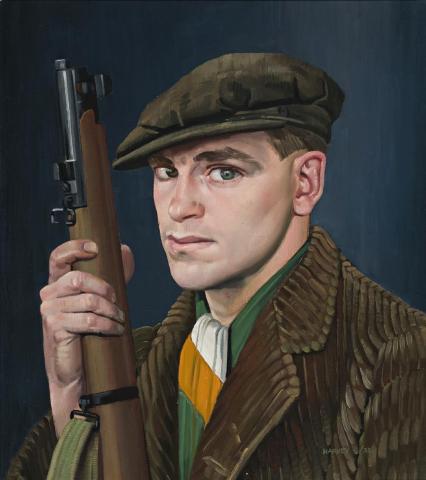SINN FEIN, 1933
Edmund Harvey
oil on canvas
46.0 x 40.5 cm
signed and dated lower right: HARVEY / 33.
inscribed verso: “SINN FEIN” / E.A.HARVEY. / 1933.
Bonhams & Bruce, Adelaide, 25 February 1998, lot 190
The Hicks Family Collection, Melbourne
Probably Paintings by E. A. Harvey, Macquarie Galleries, Sydney, 17 - 29 May 1933, cat. 2 as ‘Republican’
Probably Sydney Morning Herald, 17 May 1933, p. 8
Gregson, J. Matthew [John Young], ‘Edmund Harvey’, Art in Australia, Sydney, Series 3, no. 51, 15 August 1933, p. 35, (illus.)
When Edmund Harvey held his first exhibition in Melbourne in 1934, Arthur Streeton hailed him as ‘a clever young painter from Sydney.’1 Harvey had made his debut at the Macquarie Galleries only the year before. Although there was no work titled ‘Sinn Féin’ in that exhibition, catalogue number 2 was called ‘Republican’ sharing the top price of thirty guineas with Portrait of Miss Margaret Coen. The art critic for the Sydney Morning Herald commented on both, noting their ‘surer grasp of essentials, together with a highly acceptable feeling for the value of simplified mass effect.’ In Republican and another portrait, he observed ‘the gradual emergence of a personal point of view.’2 These comments are certainly applicable to Sinn Féin. Perhaps the title ‘Republican’ was more acceptable than the Gaelic name of the Irish Republican Party.
Harvey's Sydney exhibition had the distinction of attracting an illustrated feature article in Art in Australia. Of the four full-page illustrations of his paintings, only Sinn Féin was singled out for reproduction in colour. John Young, writing under the nom de plume of J. Matthew Gregson, enthusiastically described Harvey's progress to artistic maturity as ‘rapid.’3 Writing of his initial study at Julian Ashton's Sydney Art School in 1922, he recorded that Harvey furthered his studies in Paris, London, Florence and Rome before returning to Australia in 1928. On entering George Lambert's studio as an assistant, his art progressed under the master's example. In 1932, Young noted that his still life painting, The Buccaneer, was purchased by the Trustees of the Art Gallery of New South Wales from the Annual Exhibition of the Society of Artists. That same year he was elected a member, and his first solo exhibition followed in the next. Significantly, Young mentioned that Harvey's work in Lambert's studio ‘was mainly sculptural pointing’, the influence seen in the strong tactile quality of Sinn Féin.4
Harvey's Sinn Féin, in all its uncompromising realism is essentially a romantic image of youthful commitment to the ideal of political freedom. Founded in 1905, the Republican Sinn Féin Party sought the independence of Ireland as a sovereign state. The angle of the head, look in the eyes and firm grip on the rifle in Harvey's painting symbolise the determination with which the young Sinn Féiners sought their goal. Apprehension combined with courage indicate that their role is not an easy one. As in the scarf in Harvey's painting, the Sinn Féin adopted the tri-colour of green, white and orange - green of the native Irish clans, orange for the Ulster settlers, and white the peace between the two. As Herbert Badham wrote, ‘Harvey's work is strong, and true and resonant in colour.’5
1. Streeton, A., ‘Work of Sydney Artist; E. A. Harvey's Paintings’, Argus, Melbourne, 17 August 1934, p. 7
2. ‘Mr. Harvey's Paintings. The Lambert Influence’, Sydney Morning Herald, 17 May 1933, p. 8
3. Gregson, op. cit., p. 37
4. ibid, p. 38
5. Badham, H.E., A Study of Australian Art, Currawong Publishing Co. Pty Ltd, Sydney, 1949, p. 132
DAVID THOMAS
